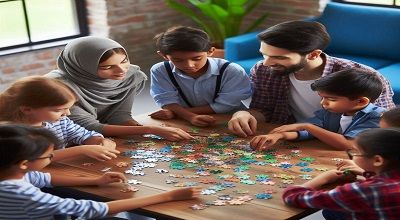Puzzle in Education
In Puzzles in Education, a puzzle refers to a problem or activity that requires creative thinking, critical analysis, and problem-solving skills to find a solution. Puzzles are often used as educational tools to engage students in the learning process. Promote cognitive development, and enhance various skills. Such as logical reasoning, pattern recognition, and spatial awareness.
Educational puzzles come in various forms. Including but not limited to:
- Jigsaw Puzzles: Physical or digital puzzles where students must assemble pieces to form a complete picture. These puzzles promote spatial awareness, fine motor skills, and visual-spatial reasoning.
- Math Puzzles: Problems or games that involve mathematical concepts and operations. Math puzzles can make learning mathematics more enjoyable and help students develop a deeper understanding of mathematical principles.
- Crossword Puzzles: Word games that require knowledge of specific vocabulary or concepts. Crossword puzzles are commonly used to reinforce and assess understanding of subject matter in various disciplines.
- Logic Puzzles: Challenges that require deductive reasoning and critical thinking. These puzzles often involve a scenario and a set of clues that students must use to deduce the correct solution.
- Coding Puzzles: Activities that involve programming and problem-solving. Coding puzzles help students develop computational thinking and programming skills.
- Riddles: Short puzzles or problems that require creative thinking to find a clever or unexpected solution. Riddles can be used to stimulate critical thinking and encourage students to think outside the box.
Examples
Certainly! Here are examples of different types of puzzles used in education:
Jigsaw Puzzle:
- Subject: Geography
- Activity: Students assemble a jigsaw puzzle of a world map, helping them learn the locations of countries and continents.
Math Puzzle:
- Subject: Algebra
- Activity: Students solve a set of algebraic equations to reveal a hidden message or picture.
Crossword Puzzle:
- Subject: Vocabulary Building
- Activity: Students complete a crossword puzzle with vocabulary words related to a particular unit of study, reinforcing language skills.
Logic Puzzle:
- Subject: Science
- Activity: Students use clues to deduce the order of events in a scientific experiment or the classification of different species.
Coding Puzzle:
- Subject: Computer Science
- Activity: Students solve coding challenges, such as debugging code. Or creating algorithms to achieve a specific task.
Riddles:
- Subject: History
- Activity: Students solve historical riddles that lead them to key figures, events, or concepts from a specific time period.
Sudoku:
- Subject: Logic and Critical Thinking
- Activity: Students fill in a Sudoku grid with numbers, promoting logical reasoning and pattern recognition.
Escape Room Challenge:
- Subject: Team Building and Problem Solving
- Activity: Students work together to solve a series of puzzles related to a particular topic or subject to “escape” within a given time frame.
Word Search:
- Subject: Literature
- Activity: Students search for words related to a literary work. Author, or literary terms in a word search puzzle.
Tangram Puzzles:
- Subject: Geometry
- Activity: Students use tangram pieces to create various geometric shapes and figures, reinforcing spatial awareness and geometry concepts.
Summary
The goal of using puzzles in education is to make learning more engaging and interactive. They encourage students to explore, experiment, and persevere in the face of challenges. Puzzles can be adapted to various age groups and subjects, making them versatile tools for educators. These examples showcase the versatility of puzzles in education, spanning various subjects and skill areas. Puzzles can be adapted and customized to suit the specific learning objectives and age groups of students.
